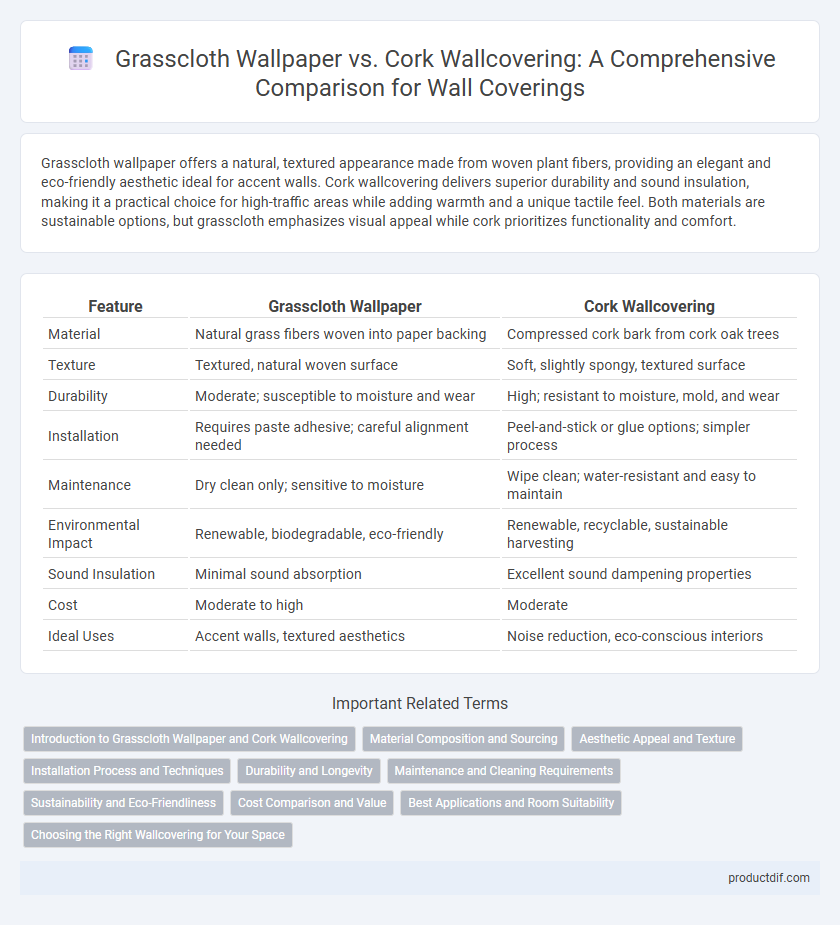Grasscloth wallpaper offers a natural, textured appearance made from woven plant fibers, providing an elegant and eco-friendly aesthetic ideal for accent walls. Cork wallcovering delivers superior durability and sound insulation, making it a practical choice for high-traffic areas while adding warmth and a unique tactile feel. Both materials are sustainable options, but grasscloth emphasizes visual appeal while cork prioritizes functionality and comfort.
Table of Comparison
| Feature | Grasscloth Wallpaper | Cork Wallcovering |
|---|---|---|
| Material | Natural grass fibers woven into paper backing | Compressed cork bark from cork oak trees |
| Texture | Textured, natural woven surface | Soft, slightly spongy, textured surface |
| Durability | Moderate; susceptible to moisture and wear | High; resistant to moisture, mold, and wear |
| Installation | Requires paste adhesive; careful alignment needed | Peel-and-stick or glue options; simpler process |
| Maintenance | Dry clean only; sensitive to moisture | Wipe clean; water-resistant and easy to maintain |
| Environmental Impact | Renewable, biodegradable, eco-friendly | Renewable, recyclable, sustainable harvesting |
| Sound Insulation | Minimal sound absorption | Excellent sound dampening properties |
| Cost | Moderate to high | Moderate |
| Ideal Uses | Accent walls, textured aesthetics | Noise reduction, eco-conscious interiors |
Introduction to Grasscloth Wallpaper and Cork Wallcovering
Grasscloth wallpaper features natural fibers such as hemp, jute, seagrass, and arrowroot, woven together to create a textured, organic look ideal for adding depth and warmth to interior walls. Cork wallcovering is made from thin sheets of natural cork harvested from cork oak trees, offering a lightweight, sustainable, and sound-absorbing material that also provides excellent insulation. Both options deliver eco-friendly, durable alternatives to traditional wallpapers, with grasscloth emphasizing visual texture and cork emphasizing functional benefits like noise reduction and moisture resistance.
Material Composition and Sourcing
Grasscloth wallpaper is crafted from natural fibers such as jute, hemp, and seagrass, handwoven into textured panels that reflect eco-friendly sourcing from renewable plants. Cork wallcovering originates from the bark of cork oak trees, sustainably harvested without harming the tree, making it a durable and renewable material with insulating properties. Both materials emphasize natural sourcing but differ in texture and durability, with grasscloth offering intricate fiber blends and cork providing a resilient, moisture-resistant surface.
Aesthetic Appeal and Texture
Grasscloth wallpaper offers a natural, woven texture that adds organic warmth and subtle visual depth to interiors, perfect for creating a sophisticated and tranquil atmosphere. Cork wallcovering provides a unique, tactile surface with a slightly rugged, rustic charm while delivering excellent sound absorption and durability. Both materials enhance aesthetic appeal through their distinct textures, but grasscloth tends to evoke elegance, whereas cork emphasizes earthy, eco-friendly design.
Installation Process and Techniques
Grasscloth wallpaper requires precise alignment of natural fibers and careful application with paste, often needing professional installation to avoid fraying and misalignment. Cork wallcovering involves adhesive backing or glue application directly on the wall, offering a simpler, faster installation that can be a DIY project. Both materials benefit from smooth, clean surfaces but cork's flexibility allows for easier handling on uneven walls compared to the delicate grasscloth.
Durability and Longevity
Grasscloth wallpaper, made from natural fibers like jute, hemp, and grass, offers a textured aesthetic but tends to be less durable, prone to damage from moisture and wear over time. Cork wallcovering, composed of natural cork bark, provides enhanced durability with resistance to impacts, moisture, and mold, making it a longer-lasting option for high-traffic or humid environments. For longevity, cork wallcoverings maintain their appearance and structural integrity significantly better than grasscloth wallpaper in demanding settings.
Maintenance and Cleaning Requirements
Grasscloth wallpaper demands delicate maintenance, requiring gentle dusting with a soft brush to avoid damage from moisture and harsh cleaners. Cork wallcovering offers more durability, easily cleaned with a damp cloth and mild detergent, making it resistant to stains and moisture. Both materials benefit from regular upkeep, but cork wallcovering provides a more user-friendly cleaning experience for high-traffic areas.
Sustainability and Eco-Friendliness
Grasscloth wallpaper, made from natural fibers like jute, hemp, and grasses, offers a biodegradable and renewable wallcovering option that enhances indoor air quality through its breathability. Cork wallcovering, harvested from the bark of cork oak trees without harming the tree, provides a sustainable, recyclable material with natural insulation and moisture resistance properties. Both materials prioritize eco-friendliness, but cork's durability and ease of maintenance often result in a longer lifespan, reducing the need for frequent replacement and minimizing environmental impact.
Cost Comparison and Value
Grasscloth wallpaper typically ranges from $50 to $150 per roll, offering a natural texture and upscale aesthetic that justifies its higher price point. Cork wallcovering costs approximately $30 to $80 per square yard, providing durability and acoustic benefits at a more budget-friendly price. When evaluating value, grasscloth excels in luxury appeal and visual depth, while cork delivers practical advantages and cost-effectiveness for noise reduction and sustainability.
Best Applications and Room Suitability
Grasscloth wallpaper is ideal for low-traffic rooms such as living rooms, bedrooms, and dining areas due to its delicate texture and natural fibers that add warmth and elegance. Cork wallcovering excels in high-traffic or moisture-prone areas like kitchens, bathrooms, and entryways because of its durability, water resistance, and sound-absorbing properties. Both materials enhance aesthetics, but grasscloth suits decorative, low-maintenance spaces while cork offers practical, resilient coverage for busy environments.
Choosing the Right Wallcovering for Your Space
Grasscloth wallpaper offers a natural, textured aesthetic crafted from woven plant fibers, ideal for adding warmth and sophistication to living rooms or bedrooms. Cork wallcovering provides excellent durability, sound absorption, and moisture resistance, making it suitable for high-traffic areas or spaces prone to humidity like kitchens and bathrooms. Selecting the right wallcovering depends on desired texture, durability, and environmental factors of the room to balance style and functionality.
Grasscloth Wallpaper vs Cork Wallcovering Infographic

 productdif.com
productdif.com